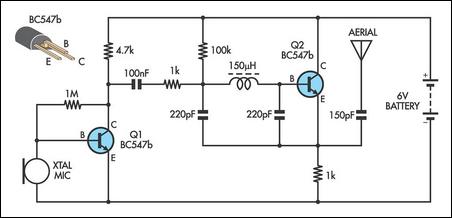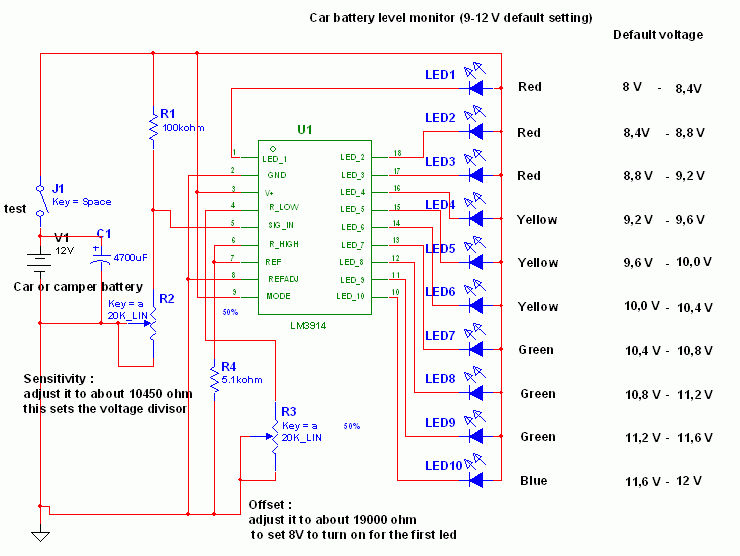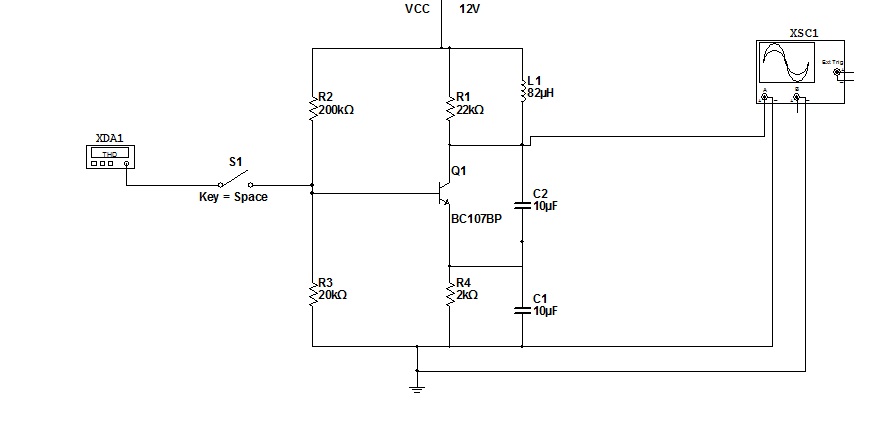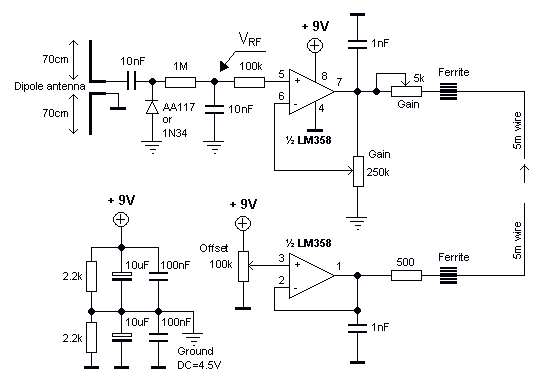
how to build simple am transmitter

This AM transmitter is designed for simplicity, featuring a non-tapped inductor with a single winding. The inductor is a standard RF choke, such as the Jaycar Cat LF-1536, eliminating the need for custom winding. To minimize the circuit's size, a conventional tuning capacitor has been replaced with fixed 220pF capacitors. Frequency tuning can be achieved by reducing one or both of these capacitors to increase frequency or by adding capacitance in parallel to decrease frequency. The transistor Q1 is biased with a 1MΩ resistor, which provides a high input impedance, enabling the use of a crystal earpiece as an economical microphone.
This AM transmitter circuit is characterized by its straightforward design, making it accessible for hobbyists and beginners in electronics. The use of a readily available RF choke simplifies the construction process, as it eliminates the complexities associated with winding an inductor. The fixed capacitors serve to stabilize the circuit size, which is particularly beneficial in portable applications.
The tuning mechanism is user-friendly; the two 220pF capacitors allow for flexible frequency adjustments. By modifying the capacitance, users can easily shift the transmitter's operational frequency to match the desired AM band. This adaptability is crucial for ensuring compliance with local frequency regulations and optimizing performance.
The biasing of the transistor Q1 with a 1MΩ resistor contributes to the overall functionality of the transmitter. The high input impedance enhances the circuit's ability to interface with low-output devices, such as crystal earpieces, which serve as microphones. This choice not only reduces costs but also simplifies the audio input stage, making the circuit more efficient.
In summary, this AM transmitter circuit stands out due to its ease of assembly, compact design, and effective tuning capabilities. It is an excellent choice for educational projects, experimentation, and practical applications in radio transmission.There are not many AM transmitters that are easier to build than this one because the inductor is not tapped and has a single winding. There is no need to wind the inductor as it is a readily available RF choke (eg, Jaycar Cat LF-1536).
To make the circuit as small as possible, the conventional tuning capacitor has been dispensed with and fixed 22 0pF capacitors used instead. To tune it to a particular frequency, reduce one or both of the 220pF capacitors to raise the frequency or add capacitance in parallel to lower the frequency. Q1 is biased with a 1MO resistor to give a high input impedance and this allows the use of a crystal ear piece as a low cost microphone.
🔗 External reference
This AM transmitter circuit is characterized by its straightforward design, making it accessible for hobbyists and beginners in electronics. The use of a readily available RF choke simplifies the construction process, as it eliminates the complexities associated with winding an inductor. The fixed capacitors serve to stabilize the circuit size, which is particularly beneficial in portable applications.
The tuning mechanism is user-friendly; the two 220pF capacitors allow for flexible frequency adjustments. By modifying the capacitance, users can easily shift the transmitter's operational frequency to match the desired AM band. This adaptability is crucial for ensuring compliance with local frequency regulations and optimizing performance.
The biasing of the transistor Q1 with a 1MΩ resistor contributes to the overall functionality of the transmitter. The high input impedance enhances the circuit's ability to interface with low-output devices, such as crystal earpieces, which serve as microphones. This choice not only reduces costs but also simplifies the audio input stage, making the circuit more efficient.
In summary, this AM transmitter circuit stands out due to its ease of assembly, compact design, and effective tuning capabilities. It is an excellent choice for educational projects, experimentation, and practical applications in radio transmission.There are not many AM transmitters that are easier to build than this one because the inductor is not tapped and has a single winding. There is no need to wind the inductor as it is a readily available RF choke (eg, Jaycar Cat LF-1536).
To make the circuit as small as possible, the conventional tuning capacitor has been dispensed with and fixed 22 0pF capacitors used instead. To tune it to a particular frequency, reduce one or both of the 220pF capacitors to raise the frequency or add capacitance in parallel to lower the frequency. Q1 is biased with a 1MO resistor to give a high input impedance and this allows the use of a crystal ear piece as a low cost microphone.
🔗 External reference





